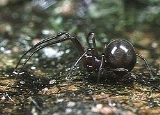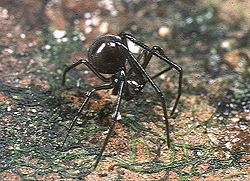
Anapidae
Encyclopedia
The Anapidae are a family of rather small spider
s with 145 described species in 35 genera. Most species are less than 2 mm long.
In some species (such as Pseudanapis parocula) the pedipalp
s of the female are reduced to coxal stumps.
Anapidae generally live in leaf litter and moss on the floor of rain forest. Many build orb webs with a diameter of less than 3 cm.
, Australia
and Africa
. However, several genera occur in Asia
(Japan
, China
, Korea
). Only Comaroma simoni and the three species of Zangherella are found in Europe
; Gertschanapis shantzi and Comaroma mendocino live in the USA.
were synonymized with this family by Schütt (2003), this move was not followed by most researchers.

Spider
Spiders are air-breathing arthropods that have eight legs, and chelicerae with fangs that inject venom. They are the largest order of arachnids and rank seventh in total species diversity among all other groups of organisms...
s with 145 described species in 35 genera. Most species are less than 2 mm long.
In some species (such as Pseudanapis parocula) the pedipalp
Pedipalp
Pedipalps , are the second pair of appendages of the prosoma in the subphylum Chelicerata. They are traditionally thought to be homologous with mandibles in Crustacea and insects, although more recent studies Pedipalps (commonly shortened to palps or palpi), are the second pair of appendages of the...
s of the female are reduced to coxal stumps.
Anapidae generally live in leaf litter and moss on the floor of rain forest. Many build orb webs with a diameter of less than 3 cm.
Distribution
Most genera inhabit New ZealandNew Zealand
New Zealand is an island country in the south-western Pacific Ocean comprising two main landmasses and numerous smaller islands. The country is situated some east of Australia across the Tasman Sea, and roughly south of the Pacific island nations of New Caledonia, Fiji, and Tonga...
, Australia
Australia
Australia , officially the Commonwealth of Australia, is a country in the Southern Hemisphere comprising the mainland of the Australian continent, the island of Tasmania, and numerous smaller islands in the Indian and Pacific Oceans. It is the world's sixth-largest country by total area...
and Africa
Africa
Africa is the world's second largest and second most populous continent, after Asia. At about 30.2 million km² including adjacent islands, it covers 6% of the Earth's total surface area and 20.4% of the total land area...
. However, several genera occur in Asia
Asia
Asia is the world's largest and most populous continent, located primarily in the eastern and northern hemispheres. It covers 8.7% of the Earth's total surface area and with approximately 3.879 billion people, it hosts 60% of the world's current human population...
(Japan
Japan
Japan is an island nation in East Asia. Located in the Pacific Ocean, it lies to the east of the Sea of Japan, China, North Korea, South Korea and Russia, stretching from the Sea of Okhotsk in the north to the East China Sea and Taiwan in the south...
, China
China
Chinese civilization may refer to:* China for more general discussion of the country.* Chinese culture* Greater China, the transnational community of ethnic Chinese.* History of China* Sinosphere, the area historically affected by Chinese culture...
, Korea
Korea
Korea ) is an East Asian geographic region that is currently divided into two separate sovereign states — North Korea and South Korea. Located on the Korean Peninsula, Korea is bordered by the People's Republic of China to the northwest, Russia to the northeast, and is separated from Japan to the...
). Only Comaroma simoni and the three species of Zangherella are found in Europe
Europe
Europe is, by convention, one of the world's seven continents. Comprising the westernmost peninsula of Eurasia, Europe is generally 'divided' from Asia to its east by the watershed divides of the Ural and Caucasus Mountains, the Ural River, the Caspian and Black Seas, and the waterways connecting...
; Gertschanapis shantzi and Comaroma mendocino live in the USA.
Systematics
Although the MicropholcommatidaeMicropholcommatidae
The Micropholcommatidae are a spider family with 33 described species in eight genera. Micropholcommatids are extremely small, with body lengths typically between 0.5 and 2 mm...
were synonymized with this family by Schütt (2003), this move was not followed by most researchers.
Genera

- Anapis Simon, 1895 — CentralCentral AmericaCentral America is the central geographic region of the Americas. It is the southernmost, isthmian portion of the North American continent, which connects with South America on the southeast. When considered part of the unified continental model, it is considered a subcontinent...
to South AmericaSouth AmericaSouth America is a continent situated in the Western Hemisphere, mostly in the Southern Hemisphere, with a relatively small portion in the Northern Hemisphere. The continent is also considered a subcontinent of the Americas. It is bordered on the west by the Pacific Ocean and on the north and east... - Anapisona GertschWillis J. GertschWillis John Gertsch was an American arachnologist. He classified a number of species, including the Brown recluse spider and the Tooth cave spider....
, 1941 — Central to South America - Caledanapis PlatnickNorman I. PlatnickNorman I. Platnick is an American arachnologist, and the Peter J. Solomon Family Curator of the invertebrate zoology department of the American Museum of Natural History. A 1973 Ph.D...
& ForsterRaymond Robert ForsterRaymond Robert Forster was a spider expert.He wrote his first paper on spiders at the age of 17. He studied at Victoria University...
, 1989 — New CaledoniaNew CaledoniaNew Caledonia is a special collectivity of France located in the southwest Pacific Ocean, east of Australia and about from Metropolitan France. The archipelago, part of the Melanesia subregion, includes the main island of Grande Terre, the Loyalty Islands, the Belep archipelago, the Isle of... - Chasmocephalon O. P-CambridgeOctavius Pickard-CambridgeThe Reverend Octavius Pickard-Cambridge FRS was an English clergyman and zoologist.Pickard-Cambridge was born in Bloxworth rectory, Dorset, the fifth son of Revd George Pickard, rector and squire of Bloxworth: the family changed their name to Pickard-Cambridge in 1848...
, 1889 — AustraliaAustraliaAustralia , officially the Commonwealth of Australia, is a country in the Southern Hemisphere comprising the mainland of the Australian continent, the island of Tasmania, and numerous smaller islands in the Indian and Pacific Oceans. It is the world's sixth-largest country by total area... - Comaroma BertkauPhilipp BertkauPhilipp Bertkau was a German zoologist who was a native of Cologne.He studied natural sciences at the University of Bonn, where in 1872 he earned his doctorate. In 1873 he became an assistant at the botanical institute in Munich, and during the following spring was an assistant at the zoological...
, 1889 — Europe, USA, ChinaChinaChinese civilization may refer to:* China for more general discussion of the country.* Chinese culture* Greater China, the transnational community of ethnic Chinese.* History of China* Sinosphere, the area historically affected by Chinese culture...
, KoreaKoreaKorea ) is an East Asian geographic region that is currently divided into two separate sovereign states — North Korea and South Korea. Located on the Korean Peninsula, Korea is bordered by the People's Republic of China to the northwest, Russia to the northeast, and is separated from Japan to the...
, JapanJapanJapan is an island nation in East Asia. Located in the Pacific Ocean, it lies to the east of the Sea of Japan, China, North Korea, South Korea and Russia, stretching from the Sea of Okhotsk in the north to the East China Sea and Taiwan in the south... - Conculus Komatsu, 1940 — New GuineaNew GuineaNew Guinea is the world's second largest island, after Greenland, covering a land area of 786,000 km2. Located in the southwest Pacific Ocean, it lies geographically to the east of the Malay Archipelago, with which it is sometimes included as part of a greater Indo-Australian Archipelago...
, Korea, Japan - Crassanapis Platnick & Forster, 1989 — ChileChileChile ,officially the Republic of Chile , is a country in South America occupying a long, narrow coastal strip between the Andes mountains to the east and the Pacific Ocean to the west. It borders Peru to the north, Bolivia to the northeast, Argentina to the east, and the Drake Passage in the far...
, ArgentinaArgentinaArgentina , officially the Argentine Republic , is the second largest country in South America by land area, after Brazil. It is constituted as a federation of 23 provinces and an autonomous city, Buenos Aires... - Crozetulus Hickman, 1939 — Africa
- Dippenaaria Wunderlich, 1995 — South AfricaSouth AfricaThe Republic of South Africa is a country in southern Africa. Located at the southern tip of Africa, it is divided into nine provinces, with of coastline on the Atlantic and Indian oceans...
- Elanapis Platnick & Forster, 1989 — Chile
- Enielkenie Ono, 2007 — TaiwanTaiwanTaiwan , also known, especially in the past, as Formosa , is the largest island of the same-named island group of East Asia in the western Pacific Ocean and located off the southeastern coast of mainland China. The island forms over 99% of the current territory of the Republic of China following...
- Forsteriola Brignoli, 1981 — Africa
- Gertschanapis Platnick & Forster, 1990 — USA
- Hickmanapis Platnick & Forster, 1989 — TasmaniaTasmaniaTasmania is an Australian island and state. It is south of the continent, separated by Bass Strait. The state includes the island of Tasmania—the 26th largest island in the world—and the surrounding islands. The state has a population of 507,626 , of whom almost half reside in the greater Hobart...
- Mandanapis Platnick & Forster, 1989 — New Caledonia
- Maxanapis Platnick & Forster, 1989 — Australia
- Metanapis Brignoli, 1981 — Africa, NepalNepalNepal , officially the Federal Democratic Republic of Nepal, is a landlocked sovereign state located in South Asia. It is located in the Himalayas and bordered to the north by the People's Republic of China, and to the south, east, and west by the Republic of India...
- Minanapis Platnick & Forster, 1989 — Chile, Argentina
- Montanapis Platnick & Forster, 1989 — New Caledonia
- Nortanapis Platnick & Forster, 1989 — Australia
- Novanapis Platnick & Forster, 1989 — New ZealandNew ZealandNew Zealand is an island country in the south-western Pacific Ocean comprising two main landmasses and numerous smaller islands. The country is situated some east of Australia across the Tasman Sea, and roughly south of the Pacific island nations of New Caledonia, Fiji, and Tonga...
- Octanapis Platnick & Forster, 1989 — Australia
- Paranapis Platnick & Forster, 1989 — New Zealand
- Pecanapis Platnick & Forster, 1989 — Chile
- Pseudanapis Simon, 1905 — Central and South America, Africa, South Asia, New Guinea, Hong KongHong KongHong Kong is one of two Special Administrative Regions of the People's Republic of China , the other being Macau. A city-state situated on China's south coast and enclosed by the Pearl River Delta and South China Sea, it is renowned for its expansive skyline and deep natural harbour...
- Queenslanapis Platnick & Forster, 1989 — Australia
- Risdonius Hickman, 1939 — Australia
- Sheranapis Platnick & Forster, 1989 — Chile
- Sinanapis Wunderlich & Song, 1995 — China
- Sofanapis Platnick & Forster, 1989 — Chile
- Spinanapis Platnick & Forster, 1989 — Australia
- Tasmanapis Platnick & Forster, 1989 — Tasmania
- Victanapis Platnick & Forster, 1989 — Australia
- Zangherella Caporiacco, 1949 — Mediterranean
- ZealanapisZealanapisZealanapis is a spider genus in the family Anapidae found in New Zealand.-Species:* Z. armata* Z. australis* Z. conica* Z. insula* Z. kuscheli* Z. matua* Z. montana* Z. otago* Z. punta* Z. waipoua...
Platnick & Forster, 1989 — New Zealand

